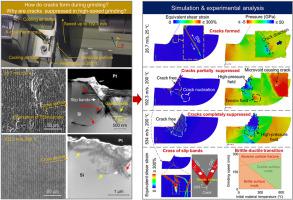International Journal of Machine Tools and Manufacture ( IF 14.0 ) Pub Date : 2023-11-09 , DOI: 10.1016/j.ijmachtools.2023.104088 Jianqiu Zhang , Xuekun Shang , BinBin He , Bi Zhang

|
Ductile-regime grinding has been used to eliminate the formation of subsurface cracks by setting an extremely small depth of cut (DOC). The critical DOC is affected by multiple factors, including the grinding speed and material temperature. The underlying mechanism of DOC affected by the grinding speed is still unclear. To reveal the role of grinding speed and material temperature during the formation of cracks, we conducted a series of single-point grinding experiments with the different grinding speeds (26.7–192.3 m/s) and the initial material temperatures (25–200 ). The experimental results showed that cracks were suppressed with an increase in the grinding speed and initial material temperature even when the DOC was much deeper than the critical DOC determined by the ductile-regime grinding. To understand the mechanisms underlying crack nucleation and suppression, we conducted systematic molecular dynamics simulations. Both simulation and experimental results showed that a crack can be formed by a single slip band. The crack nucleates from a microvoid within the slip band. With the aid of the local tensile stress on one side of the slip band tip, the crack nucleation forms an opening crack. The crack suppression is primarily caused by the high‐pressure field during high‐speed grinding, where the high‐pressure field superposes the local tensile stress to forming a compressive stress state that prevents crack nucleation. In addition, the brittle‐ductile transition is induced by the high temperature on the surface during high‐speed grinding. This study provides insights into building the DOC criterion for different grinding speeds and temperatures based on a ‘bottom-up’ approach.
中文翻译:

理解不同温度下高磨削速度脆性材料裂纹抑制机制
延性磨削已被用于通过设置极小的切削深度 (DOC) 来消除表面下裂纹的形成。临界DOC受多种因素影响,包括研磨速度和材料温度。DOC 受研磨速度影响的潜在机制仍不清楚。为了揭示磨削速度和材料温度在裂纹形成过程中的作用,我们进行了一系列不同磨削速度(26.7-192.3 m/s)和初始材料温度(25-200)。实验结果表明,即使当 DOC 比延性区域磨削确定的临界 DOC 深得多时,随着磨削速度和初始材料温度的增加,裂纹也会受到抑制。为了了解裂纹成核和抑制的机制,我们进行了系统的分子动力学模拟。模拟和实验结果均表明裂纹可由单个滑移带形成。裂纹从滑移带内的微孔处成核。借助滑带尖端一侧的局部拉应力,裂纹形核形成开口裂纹。裂纹抑制主要是由高速磨削过程中的高压场引起的,高压场与局部拉应力叠加形成压应力状态,防止裂纹形核。此外,高速磨削过程中表面的高温会引起脆韧转变。这项研究为基于“自下而上”的方法建立不同研磨速度和温度的 DOC 标准提供了见解。












































 京公网安备 11010802027423号
京公网安备 11010802027423号